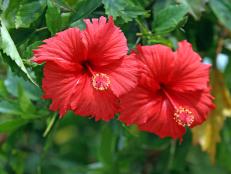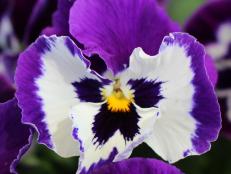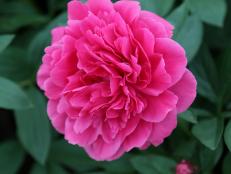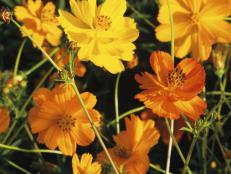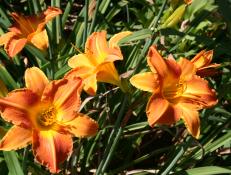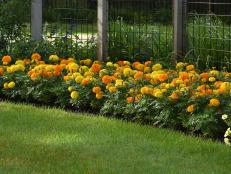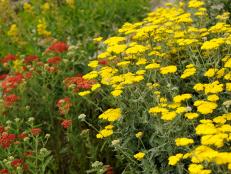Begonias: How to Plant, Grow and Care for Begonias
Discover some begonia varieties to try in your home and garden and find out how to make sure they thrive with our begonia care tips.
Begonia is a genus of about 1,300 species of annuals, perennials, shrubs and climbers. They are characterized by their fleshy stems and are mostly grown for their showy flowers or colorful leaves. They are generally easy to grow plants that will add interest to your garden throughout the growing season.

Begonia Types
Begonias can be categorized in several ways. Here are some of the most common groups of begonias:
Wax Begonias (Semperflorens)
Also known as fibrous begonias, they are the most prolific bloomers of the begonia family. This group of begonias features a fibrous root. These begonias are prized for their tight mounds of waxy leaves and bright colored petite blossoms.

Shutterstock/Christopher_PB
Semperflorens begonias, commonly called wax begonias, are one of the most popular bedding plants in the western world.
Wax begonias, typically grown as annuals, are usually sold in market packs and used as bedding plants because they proliferate, are low maintenance, and offer plenty of color for most of the growing season. They're also great in containers and hanging baskets, where they bloom in scarlet, pink, yellow, apricot, salmon and rose.
The Basics
- Bloom Time: Spring through fall
- Light Needs: Part-shade to full sun
- Hardiness Zones: 9 to 11
Cane Begonias (Angel Wing Begonias)
This group of begonias is commonly referred to as angel wing begonia. They are evergreen, perennial plants with an upright growing habit. Cane begonias have woody stems with bamboo-like joints. They are grown for their impressive form as well as attractive leaves and flowers. Angel wing begonias are popular houseplants.
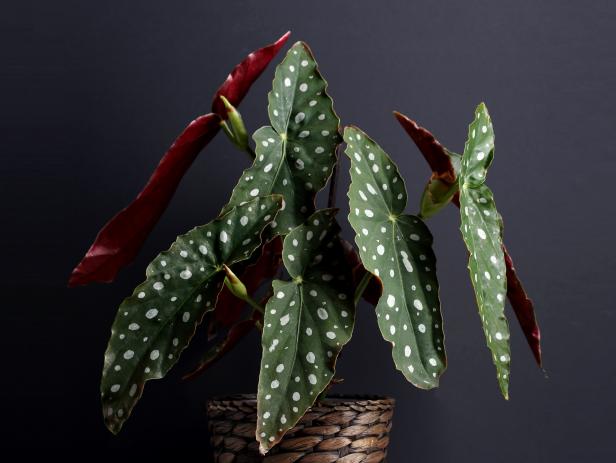
Shutterstock/Hvoya
Begonia maculata, also known as the Polka Dot begonia.
The Basics
- Bloom Time: Seasonal
- Light Needs: Part shade
- Hardiness Zones: 10 to 11
Tuberous Begonias
Most gardeners are familiar with tuberous begonias. This group features a large and diverse collection of brightly colored, summer-blooming flowers with waxy petals. Tuberous begonias are characterized by their thick tubers that store water and nutrients. Cultivars in this begonia group are mainly grown for their showy flowers and are ideal for hanging baskets, window boxes, garden beds, borders and more.
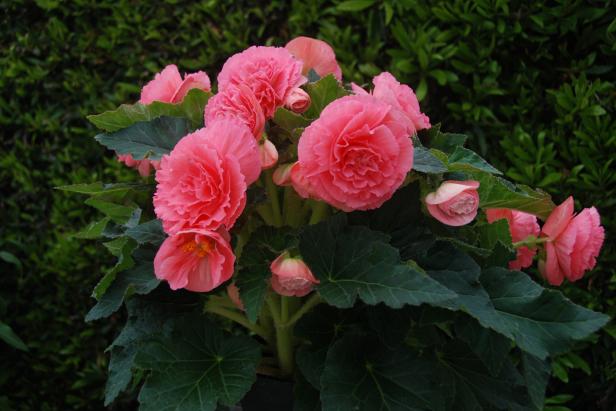
Ballseed
Amerihybrid 'Ruffled Pink' tuberous begonia.
The Basics
- Bloom Time: July to September
- Light Needs: Part shade
- Hardiness Zones: 9 to 11
Rhizomatous Begonias
These begonias are mostly grown for their foliage, and many varieties resemble Rex types. This begonia group features a compact, mounding habit with large, often colorful leaves from thick rhizomes that grow along the soil surface. The group encompasses hundreds of species and thousands of cultivars and hybrids. The flowers are typically white or pink.
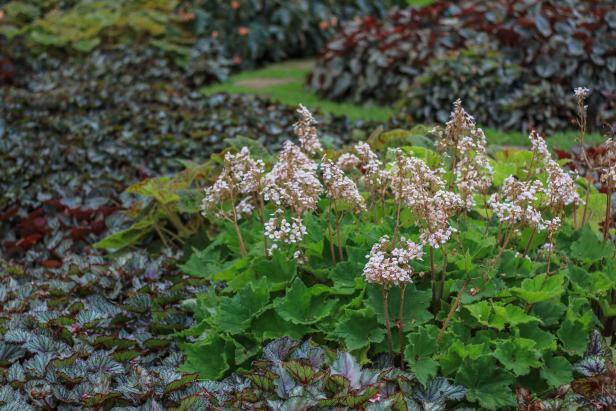
Shutterstock/Dwi Windaryanto
A bed of rhizomatous begonias.
The Basics
- Bloom Time: Seasonal
- Light Needs: Part shade to full shade
- Hardiness Zones: 10 to 12
Rex Begonia
Rex, or rex-cultorum, is a subcategory of rhizomatous begonias. They get their unique recognition because they are popular houseplants. These begonias are widely hybridized and cultivated for their showy foliage. In contrast, the flowers produced by Rex begonias are relatively insignificant. The leaves range widely in color, texture and size. Although most rex begonias grow from a thickened stem structure called a rhizome, they are not classed with other rhizomatous begonias.

Ballseed
'Jurassic Green Streak' rex begonia.
The Basics
- Bloom Time: Year-round (indoors) unremarkable blooms
- Light Needs: Bright, indirect
- Hardiness Zones: 10 to 12
Interspecific Begonias
Interspecific begonias are a cross between two species of begonia. Begonias in this group tend to be larger with more prominent blooms. Most interspecific varieties feature flowers in shades of red, pink, and white and will bloom profusely until frost. Interspecific begonias are used in both garden beds and containers. One of the most popular varieties is dragon wing begonias.
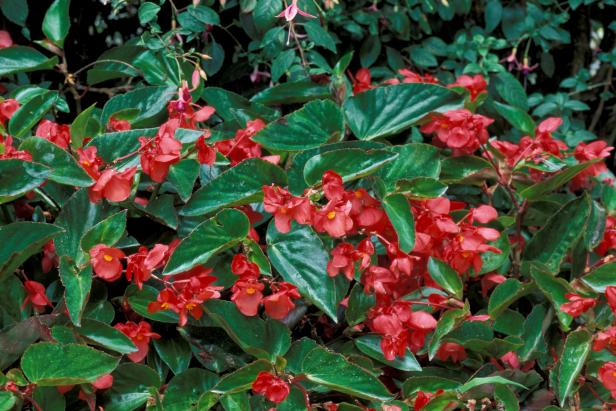
GettImages/REDA&CO
Dragon wing begonia.
The Basics
- Bloom Time: Seasonal
- Light Needs: Shade, partial sun
- Hardiness Zones: 9 to 11
Rieger Begonias
These are the gorgeous flowers you often see sold as disposable plants in nurseries and garden centers in late winter or early spring. They are prized for their waxy green foliage and brightly colored flowers that bloom bountifully from spring until autumn. Botanically they are known as Hiemalis begonia or Elatior begonia. Originally Rieger was a cross between wax begonia and tuberous begonia. However, the variety has since evolved into a category of its own. Riegers are available in bright red, yellow, pink, white and orange.
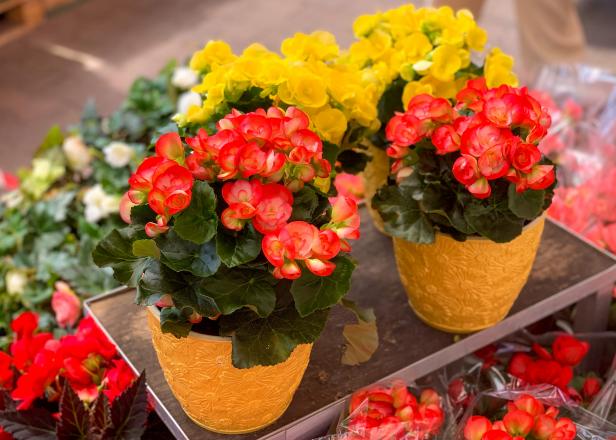
Shutterstock/Maria Pomelnikova
Elatior begonia.
The Basics
- Bloom Time: Seasonal
- Light Needs: Partial shade or filtered light
- Hardiness Zones: 9 to 11
How To Plant Begonias
There are many ways to get started with begonias. You can buy starter plants at the garden center, propagate begonias from cuttings or start them from seeds. Seed starting is the most challenging of the three due to the seeds' miniscule size and the length of time required for germination. Leaf cuttings root easily, but you need something to start with. Most gardeners start with young plants.
Plant both annual and perennial begonia types in partial shade, with moist, well-drained soil high in organic content. They need bright light to flower, but too much direct sunlight may scorch the leaves. Ideally, choose a site with morning sun and afternoon shade or dappled sunlight beneath an open tree canopy. Bronze leaf wax begonias offer the best sun tolerance, while greenleaf plants need more protection.
Caring for Begonias
Begonias are not heavy feeders. Apply a slow-release fertilizer or a granular organic fertilizer at the time of planting to supply all of their needs through the growing season. Fertilize perennial hardy begonias in late spring each year.
Although wax begonias and some others tolerate dry conditions, all types grow best with consistent soil moisture. Planting in high-quality soil is the key. Amend garden beds with compost to boost organic content for excellent moisture balance. Apply 2 to 3 inches of organic mulch to retain moisture and buffer temperature extremes. For container plants, choose glazed pottery or plastic containers that retain moisture better than unglazed terra cotta. Water often enough to keep the soil from drying out.
Prevent plant stress that leads to disease and pest problems by giving your begonias the right growing conditions. Excessive moisture from frequent overhead irrigation invites disease problems. Water outdoor flower beds in the early morning, when the foliage is already wet from dew, and only when the soil begins to dry. Better still, use drip irrigation to avoid wetting the leaves. Also, avoid over-fertilizing, as too much plant food results in too much soft plant tissue, which attracts insect pests.
Growing Begonias Indoors
The best way to ensure the survival of any begonia houseplant is to select the proper location indoors that matches their lighting needs.
Rhizomatous and fibrous-rooted species like Rex begonias are often grown as houseplants. While you can grow tuberous begonias indoors, they are harder to take care of due to their light and humidity needs.
Like most houseplants, begonias prefer bright, indirect light and plenty of humidity. If the air in your home is dry, especially in the winter, set the begonia houseplants on a shallow tray filled with pebbles and water, but keep the water level below the pebbles to prevent water from wicking into the pot through capillary action. Or, invest in a small humidifier.
While begonias enjoy a humid environment, that doesn't mean that they need frequent watering. Allow the top inch or so of potting soil to dry out before giving your potted begonia a good drink. It's a good idea to water until it runs out of the bottom of the pot to make sure that the soil is completely saturated.
Also, begonias love company. Amanda Spangler, a horticulturist and lecturer for the University of Tennessee's Department of Plant Sciences, suggests grouping a few of your favorite houseplants together to create a microclimate of increased humidity in the area around your begonia plants.
In cold regions, wintering hardy tuberous begonias inside is an excellent way to keep them from year to year. These types perform best in a brightly lit room, but indoor humidity is drier than these plants prefer.
Repotting Begonias
When your begonias are ready to move into a bigger pot, choose a container that is only an inch or so larger than its current pot.
"Putting a small begonia in a big container or potting one before the plant is ready for an upgrade may lead to root rot and other fungal problems," says Spangler.
Choose a potting mix that has some good organic matter or a soil-less mix with slow-release fertilizer mixed in. If you are happy with the size of the pot that your begonia is currently growing in, you don't necessarily need to re-pot it to maintain a healthy plant.
Topdress with an inch or so of fresh potting mix every year and root prune if needed.







